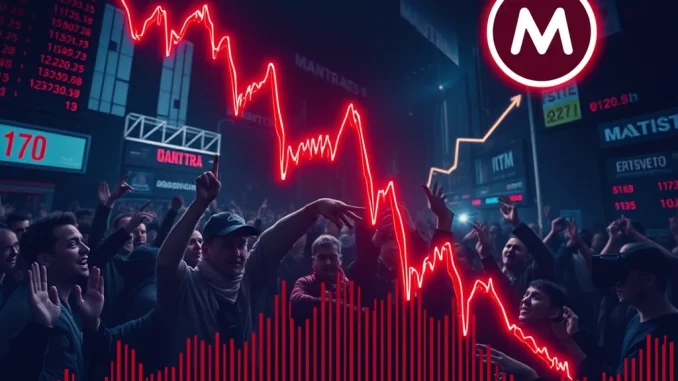
The cryptocurrency market is known for its volatility, and recent events surrounding Mantra (OM) have been a stark reminder of this. On April 14th, the price of Mantra (OM) experienced a significant downturn, plummeting below the $1 mark. This sudden Mantra price crash sent ripples through the crypto community, prompting investors and analysts alike to seek answers. Was this a case of early holders cashing out, or was there a larger force at play? Leading on-chain analytics firm Glassnode stepped in to investigate, and their findings, shared on X, shed light on the true drivers behind this dramatic price movement.
Decoding the Mantra Price Crash: Beyond Early Holders
When a cryptocurrency’s price takes a nosedive, the immediate suspicion often falls on early investors – the so-called ‘whales’ – who might be taking profits. However, Glassnode’s analysis of the Mantra price crash points to a different narrative. Their on-chain data revealed a crucial detail: there were no significant exchange inflows of OM tokens *before* the price plummeted. This is a critical piece of evidence because large exchange inflows typically precede sell-offs initiated by major holders looking to liquidate their positions.
So, if it wasn’t the early holders triggering the crash, what was it? Glassnode’s deeper dive into the on-chain metrics suggests the market sell-off was fueled by a different kind of pressure – retail panic and forced liquidations. Let’s break down the key indicators that paint this picture:
- Top 1% Holder Concentration: This metric tracks the percentage of the total OM supply held by the top 1% of addresses. During the price crash, this concentration saw a sharp decline. This indicates that larger holders were *not* initiating the sell-off; instead, their holdings were likely being reduced due to broader market pressures.
- Realized Cap Drop: Realized cap provides a view of the aggregate value of all coins at the price they were last moved on-chain. A sharp drop in realized cap during the crash signifies a widespread decrease in the perceived value of OM holdings across the market, again pointing towards broader selling pressure.
- Surge in Transfer Counts: The number of OM token transfers spiked dramatically. This isn’t typical of whale-driven sell-offs, which tend to involve fewer, larger transactions. A surge in transfers suggests widespread participation in selling activity, characteristic of retail-driven panic.
- Active Address Count Increase: Similarly, the number of active addresses interacting with the OM network also surged. This further reinforces the idea of widespread market participation in the sell-off, as more and more users rushed to react to the price drop.
In essence, the on-chain data paints a picture of a classic market sell-off scenario. It wasn’t a calculated move by a few large holders, but rather a cascade of selling triggered by broader market sentiment and potentially amplified by automated liquidations on leveraged trading platforms.
Retail Panic or Forced Liquidations: What Really Drove the OM Downturn?
While Glassnode’s analysis points away from early holders as the primary cause, it highlights two potential drivers for the OM price decrease: retail panic and forced liquidations. Let’s examine each of these in more detail:
Retail Panic
The cryptocurrency market is heavily influenced by sentiment. Negative news, broader market corrections, or even just fear of missing out (FOMO) in reverse can trigger panic selling among retail investors. Here’s how retail panic might have contributed to the OM crash:
- Fear of Further Losses: When prices start to decline rapidly, retail investors, who are often more emotionally driven, may panic and sell their holdings to avoid further losses. This selling pressure can snowball, exacerbating the price drop.
- Social Media and News Influence: Negative sentiment spreading on social media or negative news headlines can quickly trigger widespread panic selling, especially in a volatile market like crypto.
- Limited Understanding of Market Dynamics: Many retail investors may lack a deep understanding of on-chain metrics or market analysis. They might react solely to price movements, leading to impulsive selling decisions.
Forced Liquidations
Leveraged trading is common in the cryptocurrency market. Traders borrow funds to amplify their positions, hoping to magnify profits. However, leverage also magnifies losses. When the price of an asset drops rapidly, leveraged positions can be automatically liquidated by exchanges to prevent further losses. Forced liquidations can create a cascading effect, further driving down the price.
How could forced liquidations have impacted the Mantra price?
- Triggering Sell Orders: As OM’s price fell, leveraged long positions would have approached their liquidation price. Once these levels were hit, exchanges would automatically execute sell orders to close out these positions.
- Downward Price Spiral: These liquidation-driven sell orders add further selling pressure to the market, accelerating the price decline and potentially triggering even more liquidations in a vicious cycle.
- Amplifying Volatility: Liquidations can significantly amplify market volatility, especially during periods of rapid price decline.
Actionable Insights: Navigating Market Volatility
The Mantra price crash, as analyzed by Glassnode, offers valuable lessons for cryptocurrency investors looking to navigate the inherent volatility of the market. Here are some actionable insights:
- Understand On-Chain Data: Tools like Glassnode provide crucial insights beyond just price charts. Learning to interpret on-chain data can help you understand the underlying market dynamics and identify potential sell-off triggers or buying opportunities.
- Manage Risk with Leverage: Leveraged trading can be tempting, but it significantly increases risk. Understand the liquidation risks and consider using leverage cautiously, especially in volatile markets.
- Control Emotional Reactions: Fear and panic can lead to poor investment decisions. Develop a trading strategy and stick to it, even during market downturns. Avoid impulsive selling based on short-term price fluctuations.
- Diversify Your Portfolio: Don’t put all your eggs in one basket. Diversification can help mitigate the impact of price crashes in individual assets.
- Stay Informed, But Filter Noise: Keep up with market news and analysis from reputable sources, but be wary of social media hype and fear-mongering. Focus on data-driven insights rather than emotional narratives.
Conclusion: Riding the Crypto Waves
The recent Mantra price crash serves as a powerful reminder of the cryptocurrency market’s unpredictable nature. Glassnode’s insightful analysis has debunked the initial assumption of early holder sell-offs, revealing a more nuanced picture of a market-driven downturn fueled by retail reactions and potential liquidations. By understanding these dynamics and leveraging on-chain data, investors can better navigate market volatility and make more informed decisions. The crypto market will undoubtedly continue to experience its ups and downs, but knowledge and a calm, data-driven approach are your best tools for riding these waves successfully. This event highlights the importance of due diligence and understanding the broader market forces at play, rather than solely focusing on individual token movements. Ultimately, staying informed and managing risk are paramount in the exciting yet often turbulent world of cryptocurrency investments.



